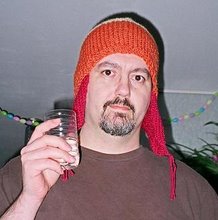The set up is based on the old Let’s Make a Deal scenario. You are given a choice of three doors. Behind one door is a new car! Behind the other two are zonks – dummy ‘prizes’ – usually a goat or animal or a wrecked tractor.
You pick one of the three doors. The host (Monty Hall), who knows what is behind which door, then opens one of the doors to reveal a zonk. He then turns to you and offers you a chance to switch your pick to the unrevealed door.
The question is, should you change your pick?
As proposed on Mythbusters, in the movie 21, and in various YouTube videos, they say that you should.
The key thing is in the explanation - in picking originally you have a 67% chance of being wrong. After being shown the zonk door, in switching to the other door you now only have a 33% chance of being wrong (or if you don't believe the math, a 50% chance of being wrong). Both beat the original 67% chance you had.
I still believe that the assumption is wrong though. Once you open that extra door, why would your 1/3 odds still remain at 1/3? Once a door is shown, why would it not change to 1/2? Think of it this way, at the beginning, whether you have picked a zonk or a car, Monty will still show a zonk, leaving the other door either a zonk or a car. The fact that you only had a 1/3 of guessing the car right from the start does not change the fact that when he offers you the choice to switch you now have a 50% chance of the car being behind either unshown door – one of which you have already picked. The key point in this is that you can now not pick the one door that he has shown you not to be a zonk.
Another example is flipping an unbiased coin heads 3 times in a row. At the onset, you only have a 1/8 chance of success or ½ x ½ x ½. However, after already flipping heads twice your odds of the third flip also being heads doesn’t remain at 1/8 but now becomes 50%.
Since the internet seems determined about this think of it this way - Try reversing it - pick two doors at the start instead of one. This gives you a 33% of not picking the car. Monty then opens one of your doors and shows a zonk and offers you a chance to switch.
Since you haven't done anything to the other door that you originally picked you are now being offered a 50/50 chance again between the remaining two doors - one of which you had picked at the onset.
- - - - -
update
Nope - turns out they were right all the time.
After arguing on the Mythbuster forum I come to this:
You pick door 1 - you have a 1/3 chance of being right at the start and a 2/3 chance of picking a wrong door. Monty removes 1/3 of the doors - 100% of the wrong one and 0% of the right one, 0% of being the door you picked.
However, at the time of the choice, you now have two doors each of which was originally only 1/3 a chance of being the car.
If you had picked the car to start (1/3 of the time) and now switch you have 0% chance of winning. If you hadn't picked the car to start (2/3 the time) and switch you now have a 100% chance of winning.
That's what I get for questioning Mythbusters.
Subscribe to:
Post Comments (Atom)

No comments:
Post a Comment